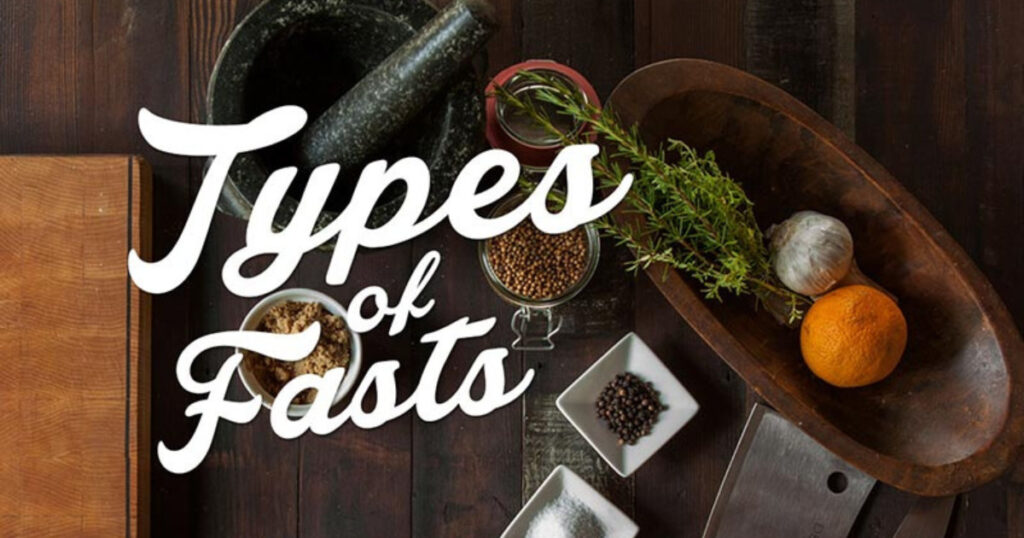There are a number of different fasting types, from religious or spiritual fasts, to fasts for health benefits. As a result of the variance, there are a number of different sub-fasting categories, such as intermittent fasting or partial fasting.
In this article, we will take a look at the different types of fasting, as well as their meaning, health benefits and what to look out for.
Religious or Spiritual Fasts
When you look more closely at the spiritual aspects of different fasting types, fasting is a common term in most major religions. There is the Christian Lent and the Islamic Ramadan which are a compulsory part of the religion. While it is voluntary, Hinduism and Buddhism both also contain aspects of fasting. Even new-age spirituality incorporates and encourages it. 1 2 3 4
If the world’s major religions all encourage fasting in some aspect, there have to be some positive effects of its results, either physically or mentally. We’re not going to dig deep into theology here, we will look at the physical side to fasting.
Types of Health Benefit Fasts
Today, religious fasting still exists. However, fasting is not solely limited to religious or spiritual reasons. There are some fasts that have been studied and proven to be beneficial to the human body in one way or another.
Below we will go through the common types of fasting and some of the sub-fasting categories.
Intermittent Fasting
Intermittent fasting is probably the most popular of the different fasting types we will look at here. It is a common term used to describe one of the more widely applied fasting methodologies.
The types of health benefits that fasting could provide will vary depending upon your circumstances, and how you apply a fast. Types of fasting that are categorized as intermittent fasting are very likely to include:
Fasting for two days a week
This is where for two days a week (known as the 5 and 2 diet) you limit your caloric intake to between 500 and 600 calories for the day. It is important to note that the two days in this fasting approach must be separate to give your body the chance to recover. 5 6
Alternate day fasting
Similar to the two-day fasting method this fasting approach requires you to reduce your caloric intake to between 500 and 600 calories a day. The point of difference being that you have one day on the fast, followed by one day off the fast.
During the off day, you must maintain a healthy diet. Loading up on empty calories will bring with it complications where you will begin to suffer based on an accumulative deficiency.
Fasting windows
This is probably the most popular form of fasting today and really should be at the top of the list of different fasting types we’re considering. It involves setting up a window of your day where you can consume your caloric intake. An example could be the 16 and 8 fast.
This is where you select a period of 8 consecutive hours in which you can consume your food, and then you fast for the remaining 16 hours.
The fasting period can of course be allocated to hours in which you are sleeping. This is believed to be a much better approach as the body is able to assimilate the nutrients provided through the food during the recovery stages of your day.
The best time for recovery is when you are sleeping. The body shuts down a range of different functions and focuses on repairing damage and cellular deterioration.
Depending on how strict you are, the fasting period may or may not contain calorie free items such as black coffee or non-fruit tea.
The Warrior Diet
The Warrior Diet sounds like the toughest of the different fasting types we’re looking at here. It is similar to fasting windows, however, you have a 4 hour window at the end of your day to eat before bed.
You must be consuming nutrient dense foods using this method, due to the small eating window.
Meal skipping
This is the simplest method in the world of different fasting types to start with as all it involves is removing one meal from your daily routine. For example, skipping breakfast and waiting for lunch or eating a larger lunch and missing dinner.
There are also many sub-fasting categories of fasting:
Water fasting
A water fast sounds like one of the more challenging of the different fasting types we’re considering. It typically involves consuming nothing but water. Water fasting normally last between 24 and 72 hours. It is recommended that you prepare yourself for fasting in the days leading up to starting a water fast.
It is also recommended that you seek medical advice, especially if you plan to carry on fasting for longer than 72 hours. 7
It is permissible to have an apple if the pangs of hunger get to be too much during a water fast. This is of such a low caloric value that it will be negligible.
However, the process of fasting is not so much about the reduction in calories with water fast as it is about limiting the body’s need to enter the digestion process.
A water fast allows the body to stay in a detoxification state for a longer period, and flush out more metabolic waste than if you were to continue eating. Of the different fasting types, this is often looked upon as being more drastic by those who have not completed a water fast.
Sea moss is another consumable that you can have during a water fast, and many rely upon this for its high mineral content.
As the body is not working hard to break down food and process it, it is able to take the minerals from the sea moss. It is also able to direct them towards the healing process for a range of organs, connective tissue, blood and even your skin, hair and nails.
Juice fasting
Also referred to as juice cleansing, a juice fast is often completed on the back of a water fast. As one of our different fasting types, juice fasting involves consuming nothing but juices. By juicing specific fruits and vegetables whole you retain the majority of the nutrients and high fiber content.
This allows the body to process the juice with a minimal load on the digestive system. It is recommended that at an overall level your juices consumed are about 80% vegetables and 20% fruits.
It is not recommended to use an eating window or timing restrictions when juice fasting as these are usually low in protein. As a result, limiting your caloric intake can actually be harmful to the body.

Substance fasting
Have you heard of substance fasting before? Prior to doing my research on different fasting types beyond the approaches I have experience with, this kind of fasting is where you abstain from certain substances which may currently be in your life. This could mean giving up substances such as tobacco, caffeine, alcohol, or even recreational drugs for a period of time.
Cutting things like these out of your day will allow your body to recover from their impacts. Many substances have cumulative effects, and consistently taking them all too often results in complications.
These complications are linked to toxicity levels in the body being maintained, or topped up, as your body does not get the chance to eliminate these.
With their absence, any toxicity levels associated with certain substances will progressively diminish. Keep in mind that there can be strong and unpleasant withdrawal symptoms experienced, depending upon the substance.
Partial fasting
Of the different fasting types, this is where you give up certain foods or drinks. Examples could include meats, dairy products or soft drinks.
Deciding to undertake a fast is a decision you should be well prepared for. It is recommended you check in with a health professional if you are undertaking any full-on fasts such as the warrior diet or fasts lasting longer than 72 hours.
If you are new to fasting and would like to give it a try, I would recommend starting with either skipping one meal a day or by undertaking a 12/12 fasting window until your body adjusts.
I found the 16/8 fast to be the most beneficial for me and my body, but as with all things it is best to try and see what suits you and your needs best!
Considering the different fasting types, which do you find aligns best with your way of lie and needs? Tell us in the comments below.
Reference
- “fasting” – Britannica Staff, Last checked 29 February 2024 [Britannica] [Archive] ↩︎
- “Ramadan Information Sheet” – ING Staff, Last checked 29 February 2024 [Islamic Networks Group] [Archive] ↩︎
- “Fasting in Hinduism” – Alimentarium Staff, Last checked 29 February 2024 [Alimentarium] [Archive] ↩︎
- “Buddhism” – National Geographic Society, Last checked 29 February 2024 [National Geographic Society] [Archive] ↩︎
- “The Beginner’s Guide to the 5:2 Diet” – A. Bjarnadottir, 14 October 2022 [Healthline] [Archive] ↩︎
- “World-first study shows benefits of 5:2 diet for people with diabetes” – UNISA Staff, 23 July 2018 [University of South Australia] [Archive] ↩︎
- “Water Fasting: Benefits and Dangers” – R. Raman, 14 October 2022 [Healthline] [Archive] ↩︎
Last Updated on 5 months by D&C Editorial Team





Does fasting for religious reasons give same benefit?
Hello Sama,
Fasting for health reasons, or religious reasons will provide you with the same benefits. Although, some people who are devout in their beliefs will probably say that fasting for spiritual reasons has more health benefits.
I don’t know for sure, but I wouldn’t be surprised to learn that religious fasting may have a better health related outcome. If you think about it this way there could be enough rationale behind the power of intention.
I’m not a religious person, but if you are and you believe this works for you then I wish all the more power to you! I hope this helps and would be curious to hear if there have been any studies in this area of fasting.
Hello Sama,
Only a few hours after replying to your question I found this article that I thought you might be interested in. It is about the health benefits of fasting during Ramadan. There are some interesting perspectives here about how reducing your food consumption can benefit your health.